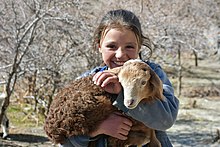
The Demographics of Tajikistan is about the demography of the population of Tajikistan, including population growth, population density, ethnicity, education level, health, economic status, religious affiliations, and other aspects of the population.

Tajiks are a Persian-speaking Iranian ethnic group native to Central Asia, living primarily in Afghanistan, Tajikistan, and Uzbekistan. Tajiks are the largest ethnicity in Tajikistan, and the second-largest in Afghanistan and Uzbekistan. They speak varieties of Persian, a Western Iranian language. In Tajikistan, since the 1939 Soviet census, its small Pamiri and Yaghnobi ethnic groups are included as Tajiks. In China, the term is used to refer to its Pamiri ethnic groups, the Tajiks of Xinjiang, who speak the Eastern Iranian Pamiri languages. In Afghanistan, the Pamiris are counted as a separate ethnic group.
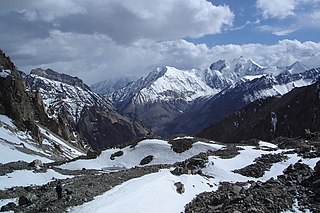
The Pamir Mountains are a range of mountains between Central Asia and South Asia. They are located at a junction with other notable mountains, namely the Tian Shan, Karakoram, Kunlun, Hindu Kush and the Himalaya mountain ranges. They are among the world's highest mountains.

Gorno-Badakhshan, officially the Badakhshan Mountainous Autonomous Region, is an autonomous region in eastern Tajikistan, in the Pamir Mountains. It makes up nearly forty-five percent of the country's land area but only two percent of its population.

Wakhi is an Indo-European language in the Eastern Iranian branch of the language family spoken today in Wakhan District, Northern Afghanistan, and also in Tajikistan, Northern Pakistan and Western China.
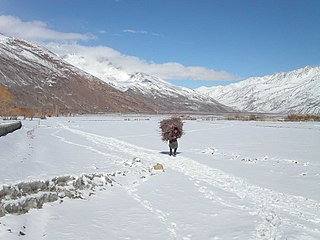
Wakhan, or "the Wakhan", is a rugged, mountainous part of the Pamir, Hindu Kush and Karakoram regions of Afghanistan. Wakhan District is a district in Badakshan Province.
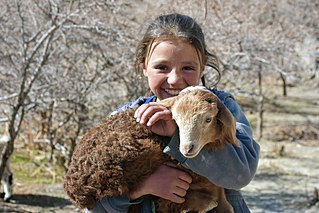
The Wakhi people, also locally referred to as the Wokhik, are an Iranian ethnic group native to Central and South Asia. They are found in Afghanistan, Tajikistan, Pakistan and China—primarily situated in and around Afghanistan's Wakhan Corridor, the northernmost part of Pakistan's Gilgit−Baltistan and Chitral, Tajikistan's Gorno−Badakhshan Autonomous Region and the southwestern areas of China's Xinjiang Uyghur Autonomous Region. The Wakhi people are native speakers of the Wakhi language, an Eastern Iranian language.

Badakhshan Province is one of the 34 provinces of Afghanistan, located in the northeastern part of the country. It is bordered by Tajikistan's Gorno-Badakhshan in the north and the Pakistani regions of Lower and Upper Chitral and Gilgit-Baltistan in the southeast. It also has a 91-kilometer (57-mile) border with China in the east.
The Pamir languages are an areal group of the Eastern Iranian languages, spoken by numerous people in the Pamir Mountains, primarily along the Panj River and its tributaries.

Darvaz, alternatively Darwaz, Darvoz, or Darwoz, or the Darvaz Khanate was an independent Pamiri principality until 1878, ruled by a Mir and its capital was at Qal'ai Khumb. The principality controlled territory on the left and right banks of the Oxus River. The major settlements of Darvaz were Qal'ai Khumb and Kham.
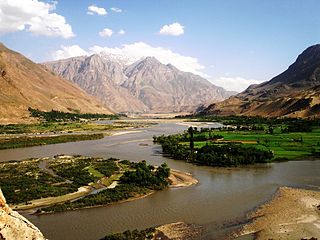
Shighnan, also Shignan, Shugnan, Shughnan, and Khughnan, is an historic region whose name today may also refer to a town and a district in Badakhshan Province in the mountainous northeast of Afghanistan and also a district in Gorno-Badakhshan Autonomous Province in Tajikistan. The administrative center of the Shighnan District of Afghanistan is called Qaleh Barpanjeh. The administrative center of the Shughnon District of Tajikistan is called Khorogh.
Oleg Fezov, or Oleg Fesov is a musician, and composer from Tajikistan, who composes and arranges his songs in addition to performing. In 1990 he graduated from Dushanbe College of Arts where he majored in sculpture. Later he decided to switch fields and soon enough he was one of the best illustrating artists of children's periodic and used to be the art director of "Mash Ap" children's magazine.

Ishkashimi is an Iranian language spoken by Ishkashimi people who live predominantly in the Badakhshan Province in Afghanistan and in Gorno-Badakhshan Autonomous Region in Tajikistan.

Shughni or Khughni, is one of the Pamir languages of the Southeastern Iranian language group. Its distribution is in the Gorno-Badakhshan Autonomous Region in Tajikistan, Badakhshan Province in Afghanistan, Chitral district in Pakistan and Taxkorgan Tajik Autonomous County in China.

Rushani is one of the Pamir languages spoken in Afghanistan and Tajikistan. Rushani is relatively closer to all Northern Pamiri languages sub-group whether it is Shughni, Yazgulami, Sarikuli or Oroshori sharing many grammatical and vocabulary similarity with all of them especially with Shughni and thus some linguists consider it a dialect of Shughni.

Murghob District is a district in Tajikistan, occupying the eastern two-thirds of the Gorno-Badakhshan Autonomous Region (GBAO). The area of Murghob District is 37,300 km2, covering 26 percent of Tajikistan's soil, but only 0.17% of its population. Murghob District borders on Kyrgyzstan to the north, China to the east, and Afghanistan to the south. The population of Murghob District is 15,900. Its administrative capital is the village Murghob.

Shighnan District is one of the 28 districts of the Badakhshan Province in eastern Afghanistan. It's part of the history region of Shighnan that is today divided between Afghanistan and Tajikistan.The district borders the Panj River and Tajikistan in the northeast, the Maimay district to the west, the Raghistan district in the southwest, the Kohistan, Arghanj Khwa, and Shuhada districts in the south, and the Ishkashim district in the southeast.
Tajiks in Pakistan are residents of Pakistan who are of Tajik ancestry. The Tajiks are a Persian-speaking Iranian ethnic group native to Central Asia, living primarily in Afghanistan, Tajikistan, and Uzbekistan.
The Shughni are an Iranian sub-ethnic group of Pamiris, who reside in the Pamir Mountains of the Badakhshan region of Central Asia. They mostly live in the country of Tajikistan, while a minority lives in Afghanistan, Pakistan, and China. They speak the Shughni language, an Eastern Iranian language of the Pamiri subgroup.
The Mirdom of Wakhan, Principality of Wakhan, or the Khanate of Wakhan was a semi-independent Wakhi principality in Central Asia that existed until 1883. It controlled both banks of the Upper Amu Darya and was governed by a hereditary chieftain known as a mir, with its capital at Qal'ah-yi Panjah.

